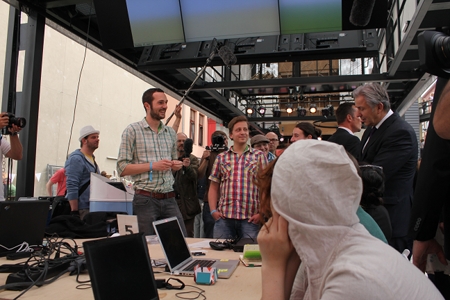Archive for the 'economy' Category
electronics thinkering tanks
Saturday, June 16th, 2012
Arduino Workshop at bmwguggenheimlab with Stefan and André
(more…)
Some music in Marzahn
Sunday, May 20th, 2012A User Had Killed My Baby
Sunday, May 6th, 2012LIMITED TIME OFFER !!!! LIMITED TIME OFFER!!!!! LIMITED TIME OFFER!!!!
mort about education
Tuesday, March 13th, 2012
monsters from a 9 yr. old, more images after the text
randform reader spitzketreiber wrote in a comment to the last blog post:
so you don’t want to mingle your kid with the normal kids in that school, isn’t that elitistic and in contradiction to the egalitarian views you expressed here on this blog?
What do you mean with egalitarian? I think every human has the right for half-way decent living conditions that is in particular everybody should have access to food, housing, education and health care, but thats not egalitarian as in the usual sense.
Moreover I didn’t say that I don’t wan’t to mingle my kid with the “normal” kids.
On the contrary. I do think that it can be good to bring rather different types of kids together. However the size of the classes and the ratio of teachers and or supervisors/social workers to pupils/group members matter a lot if you have different types of pupils/group members. I worked in the early eighties in a preschool where disabled, mentally retarded and “normal” children were brought together in one group. I found it was for all children a win. However for this project the ratio of teacher/supervisor/kid was about one teacher for 1-2 kids and this ratio was definitely necessary.
In general it is important that each kid has something to work on, something were it can grow its abilities. If you have a group of very different kids it is often not so easy to find the right means to realize this.
Like in the case of specific mind tasks you have to keep the intelligent kids busy enough with suited and meaningful tasks so that they don’t start to get too bored. Likewise slower kids need to get a task, which is adapted for them, a task were they feel not swamped and were they have enough freedom to work at their pace. Alpha animals have to be often kept at distance, cultural obstacles have to be resolved, some people need a special amount of physical workout, some people talk a lot, some people are better able to adapt etc. In general one can say the more different a group, the harder it can be to “keep the group together” for a longer time while simultanously get some work done with some portion of efficiency. Moreover with a smaller teacher/kid ratio the evaluation of abilities is more difficult. So it may happen that very different people supplement each other and may easily form a group however in the generic case one can rather observe that often either people sort themselves (“social segregation”) or that they are sorted prior to forming groups and/or that they are “streamlined” via pressure and rules (please see also the comment on the moderation of groups). Thus school classes are e.g. formed by sorting via grades and/or other aspects, like tuition etc. The bigger the classes, the less teachers there are, the more streamlining and sorting may be necessary in order to keep a certain standard. Ever done chemistry experiments with a bunch of over 30 ten year olds in a small room? I did this and I can say it can be challenging.
In a lot of the Berlin gymnasia which are mentioned in the previous blog post there seem, at least by what we have heard, to be less social and cultural differences than in that gymnasium in Marzahn-Hellersdorf at which our kids are currently. In that sense it seems the social and cultural components of difference may be lower in these schools then in this school in Marzahn-Hellersdorf and thus if you have the same amount of too many pupils this may be a learning advantage.
In the case of our son we thus have – apart from the Berlin-Bavarian problem with spanish as a second language (which wouldn’t be resolved by sending him into a “normal” class at this school and I am still quite angry that they didn’t tell us when we applied for that school that french is going to be eliminated) – to figure out wether it is better for our son to stay in his “presorted” class with a higher teacher ratio per kid, however with a higher teaching speed (“fastgoerclass”) or to change to a rather crowded class with probably more tensions due to more and more different pupils. I should also say that depite the fact that his class was already more “sorted” than a “normal” class (kids in these kind of classes have often parents which have a high interest in good education) there were already big overall tensions (especially among the boys) and that the math teacher spend his free time to speak with the boys and to establish a kind of anti-bullying system. One should also mention that the school had to undergo a major restructuring and that there is a rather high fluctuation of teachers, because of e.g. changing pupil numbers, the restructuring and school reforms. So for example my daughters class has now the fifth math teacher (temporary staff not included) in four years. Moreover an overall higher teaching speed (as said the gymnasia in Germany were roughly shortened by a year in recent times) together with higher challenges of a technological society put additional pressure on schools and kids. This school in Marzahn-Hellersdorf has some excellent teachers and it is frustrating to see how they are struggling. There was recently also a study, which displayed that the current german school system produces a lot of “loosers”, from the article Deutschland, Land der Schulabsteiger
“Selbst in Sachsen, dem informellen Sieger der neuen Studie, kommen auf einen Schulaufsteiger elf Schüler, die aus dem Gymnasium in eine niedrigere Schulform herabgestuft werden. In Niedersachsen sind es 12, in Berlin gar 14.”
translation without guarantee:
Even in Saxonia, the informal winner in the study, it was that for one fast climber there are eleven pupils which are decending from Gymnasium into a lower school form. In Lower Saxonia there are 12 and in Berlin even 14.
Big classes are of course motivated by economic considerations and similar dynamics with high teach speed and bigger “classes” take place in higher education. For example a year and a half ago Tim had to give lectures in front of about 1000 ! students – he had already to think about wether it may be necessary to split his lecture via a video screen into two lecture halls. I call this an academic Musikantenstadl.
The New York times had recently an article which conscisely summarized two major components of these dynamics. One effect is the socalled “Baumol’s disease”:
Some of that growth has resulted from a phenomenon called Baumol’s disease, after the economist William J. Baumol, who described it in a 1965 article he wrote with William G. Bowen. The basic idea is that while productivity gains have made it possible to assemble cars with only a tiny fraction of the labor that was once required, it still takes four musicians nine minutes to perform Beethoven’s String Quartet No. 4 in C minor, just as it did in the 19th century.
College instruction more closely resembles a musical performance than an auto assembly line. Although information technologies have yielded some productivity growth in academia, instruction still takes place largely as it always has.
In some sense one can see this dynamics as a indication that humans (the training of, the maintanance of etc.) are loosing against the market competivity of machines and this is not only the case for the industry sector but increasingly also the case for the socalled knowledge economy. Note in particular that teaching becomes especially part of the monetarily sucessful section of knowledge economy if it is not mainly concerned with teaching “mentally weak” humans (or whoever appear as such) but humans which are able to construct, run and maintain high tech, i.e. “machines.”
This becomes also apparent in the second phenomenom which lies according to the New York times in “prestige hunting” (and the corresponding tuition costs):
“After adjusting for inflation, starting salaries for most graduates have remained essentially stagnant for several decades, while those at the bottom of the group have actually declined. Only the highest-paid graduates have enjoyed significant salary growth, and among those a very thin slice at the top has seen truly spectacular increases.
Because of the bitter competition for those premium salaries, elite educational credentials are often a precondition for even landing a job interview. With so many applications for every vacancy, many consulting firms and investment banks, For example, now consider only candidates from a short list of top-ranked schools.”
That is consulting firms and investment banks are of course to a great extend part of what can be seen as “knowledge economy”, in particular sophisticated financial instruments make extensive use of computers, i.e. “machines” and the humans, which are assumed to be able to create e.g. the best computer programs and financial models are thus more sought after.
More components like growing social inequalities and declining ressources play of course also a role.

car and gadget design from a 10 yr. old
Berlin schools
Saturday, March 3rd, 2012
When our son, who is now in 6th grade was about to enter the 5th grade we decided that a higher school (gymnasium) would be better suited for him then the class in the grammar school on which he was at that time. Unfortunately this was only possible by entering a socalled “Schnellläuferklasse” (Fastgoerclass means one year school is skipped), which we didn’t find optimal, but since the school which he could go to (in Marzahn-Hellersdorf) was actually good (our daughter was already there) we decided we could go with this. Unfortunately it turned out last year that the school doesn’t have any more capacities to offer french as a second language (as what we would have chosen) but only spanish. Since Tim works in Munich and there are no higher schools in Munich which offer spanish as a second language moving back to Munich would be a problem with a choice of spanish as a second language (second languages start usually in the 7th grade). Moreover we are not really happy with the concept of Schnellläuferklasse* (especially since school time had already been drastically shortened in Germany) , so we were considering a school change. Unfortunately our son has (including preschools) already visited 7 different schools on 3 different continents so we are very reluctant about another change. Moreover we got sofar rejections from most of the gymnasiums which are halfway reachable (Berlin East) and which somewhat support his affinity for art and natural sciences that is we received rejections from: Coppi-Gymnasium, Otto-Nagel-Gymnasium and Dathe Gymnasium. The Heinrich-Hertz-Gymnasium fell out of choice for several reasons. He is on the waiting list of one Gymnasium in Marzahn-Hellersdorf, which would be a last possibility for a change, but we don’t know much about that school. If someone has any tips on that issue please let us know.
*there were actually more parents in his class unhappy with this concept and there were discussion wether one should give up the Schellläuferklasse Concept (there was a little time window last year for doing this). In a Schnellläuferklasse kids which are good in school are gathered and there are less kids in such a class then usual, so the majority of parents from that class at that school in Marzahn-Hellersdorf found the perspective to mix their kids into an overcrowded class less apealing.
knowledge economy
Tuesday, February 28th, 2012In the content of the previous blogpost I used the word knowledge economy. In an Interview, which was given at the Innovationsforum 2010 Prof. Wurzer of the Steinbeis Transfer Institute gives an introduction to the difference between classical industrial economy and knowledge economy.
Citation form the transcript of the interview (without guarantee that I heard everything rightly):
[…] da erleben wir eben, das wir heute immer weniger Geld damit verdienen Produkte herzustellen, die man sozusagen anfassen kann [..gives examples for tangible products…] all die Hersteller, die Dinge produzieren, die man anfassen kann die haben eine relativ geringe Produktivität [..thats what I understand he probably menat Profitabilität…] und die Unternehmen die weiter hinten in der Wertschöpfungskette stehen also zb der Telekom Provider, die haben schon eine etwas höhere Profitabilität und Unternehmen, die dann ganz hinten stehen, wie zb Research in motion, also Blackberry, die haben eine extrem hohe Profitabilität. Und so ein Unternehmen wie Blackberry das betreibt bestenfalls noch Rechenzentren, wenn sie das überhaupt tun, genaugenommen ist alles was das Unternehmen macht einen Übertragungsstandard zur Verfügung zu stellen, ihn zu lizensieren und insofern also ein vollkommen immaterielles Geschäftsmodell zu betreiben. […]
Translation without guarantee:
[…] we see here that we earn less and less money with tangible products [..gives examples for tangible products…] All those producers which produce tangible products have a relativ small productivity [..thats what I understand he probably meant profitability…] and companies which stand at later stages of the value chain, like the telecom provider have a higher profitability and companies at very later stages, like research in motion, i.e. Blackberry are extremely profitable. And a company like Blackberry operates at best data centres, if at all. Strictly speaking all what the company does is to provide a broadcasting technology, to licence it and thus to provide a completely immaterial business model.
There is eventually more to hear on that issue at the trendforum 2012 for those who want and can pay the conference fee of 1980 Euro +tax for march 21 and 22 in 2012 in Berlin.
Energy demand, economy and virtual values
Saturday, February 25th, 2012There is now a new subsection Energy demand, economy and virtual values to the section Economic growth and limitations of the article draft: New economic schemes in games at Azimuth, which adresses the different uses of intellectual properties.
Tracing intellectual properties and a lockable patent archive
Friday, February 17th, 2012Nad wrote: “In addition I proposed to the people at arxiv to introduce a closed pre-preprint section for the arxive for timestamping works (something I am going to talk about later in more detail)”
Why did you write to the arxiv people? You should have made that public!
The recent protests against journals could have started much earlier if all people would have published their ideas earlier!
With “protests” Sheila is probably referring to the current protests against the publisher Elsevier and the increasing discussions (see e.g. the forum math2.0) about different models for scientific publishing and mathematical software.
My answer to this: I actually “made this public” in a comment on the math blog n-category cafe. The search button at the n-category cafe doesnt work to good, so I currently can’t find the comment. It must have been something like in 2009. In this n-category cafe comment I explained that it would be good to establish a “lockable section” at the archive (see below) with review function, so this kind of discussion has been prevalent for a while within the math/physics community. As a major application for such a “lockable section” I had actually the review and guidance of Ph.D. thesis’ in mind (a “pre-preprint section”), rather then, whats currently more discussed, the review of finalized articles. Apart from the n-category cafe comment I explained the concept also in this randform post. It may sometimes take a while for a discussion to grow and gain importance.
The underlying concept for these kind of software solutions and in some sense also for the discussion itself is what I would like to call “the traceability of intellectual properties”. On the Azimuth project wiki I recently tried to explain this concept a bit more. Moreover I transferred the concept also to other intellectual property issues, in particular to patents. This resulted in a proposal for a lockable patent archive.
After the click you may find a copy of the current Azimuth project wiki entry.
Short comment: In the above mentioned randform post the revocation of Germany’s former minister of defense Karl-Theodor zu Guttenberg’s doctoral degree following accusations of plagiarism was mentioned. Despite the revocation of his degree it seems he may still be a rather good law expert (at least thats what I understood from the comments of his coworkers). In addition he seems to be an expert on some internet software related issues . I could imagine that the legal subtleties of such online legal facilities could be an interesting subject for a new Ph.D. thesis, but of course I am not his advisor :)
mini nuclear wastes
Saturday, January 21st, 2012The discussion about certain nuclear waste problems which was indirectly adressed in my previous post about mini nuclear reactors went a little further on the blog Azimuth (here, here and here). Connected with the Azimuth blog is the socalled Azimuth project and the Azimuth forum, where amongst others people voluntarily discuss scientific studies on climate and environmental issues and even do some related software projects (like for example this here). So in the comment I suggested that someone could eventually do the necessary calculations to check wether there is a higher cancer rate in the San Francisco Bay area which may be due to a nuclear waste site in the waters close to San Francisco. Likewise one could eventually do similar calculations for the 25000 undersea radioactive waste sites in Russia mentioned in the post about the mini nuclear reactors or to other known sites in the world (see also this post and this comment about sites in India). It would of course also be interesting to hear about related studies.
related randform posts:
->on a recent study of increased risk of cancer in the vicinity of german nuclear power plants
->On the socalled Greiser-study
-> and the general overview on nuclear science posts on randform






